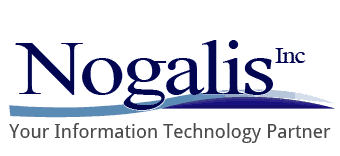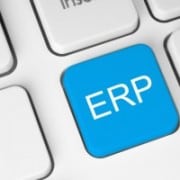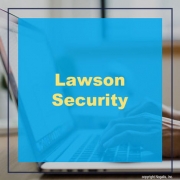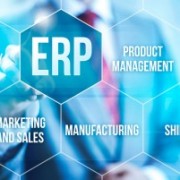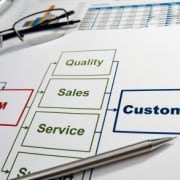Earlier this month, Infor acquired supply chain management cloud software GT Nexus for $675 million, a move to broaden the capabilities of its Enterprise Resource planning (ERP) software. With customers including the likes of Adidas Group, Caterpillar, Columbia Sportswear, Levi Strauss & Co., Maersk, Pfizer, and UPS. Infor’s aims to strengthen its portfolio as the retail industry continues to shift towards contract-based manufacturing. Charles Phillips, chief executive of Infor, states “Together, Infor and GT Nexus will provide customers with unprecedented visibility into their supply chains to manage production and monitor goods in transit and at rest.”
An academic medical center in New Hampshire is working to revolutionize healthcare with predictive analytics, wearable devices and the cloud. “It’s important to think about healthcare being on the precipice of what I think of as an industrial revolution,” says Dr. Jim Weinstein, president and CEO of Dartmouth-Hitchcock Health System. Weinstein’s goal is to improve patient outcomes, reduce costs and deliver more personalized care. To get there, healthcare providers must implement technology in a more automated, systematic way.
Connected devices such as blood pressure cuffs, pulse oximeter devices and activity tracker would collect data to be transmitted to the Azure Cloud via smartphone, where it’s pulled into a Cortana Analytics Suite dashboard at a contact center, helping to prevent people from getting sick in the first place by providing physicians with actionable data that can help them provide personal, optimal care.
Implementing Lawson Security is a relatively simple and straightforward procedure. If you are planning on taking on this challenge in-house we encourage you to follow the following steps:
- Spend time on gathering your requirements. This is by far the most important step of the process and you should have a good working document to begin with. If you need templates to start with, feel free to use our templates.
- Come up with a really great naming convention up front. This will save you all kinds of headaches in the long run. I like to add the word “Role” to all my roles, and “CLS” to all my classes, because later it makes them easier to read and understand as I’m trying to debug. You can come up with your own ideas but keep them consistent.
- Make sure you have a good backup process for your LDAP data and you have tested it. There is nothing worse than losing your entire implementation because of corrupt LDAP instances. It happens more than you know.
- Rome wasn’t built in a day. Don’t try to implement all the wishlist of every department in the first phase. Give them the necessities. After they have tested and accepted them, then move on to the fancier stuff.
- Ask us for a 30-day trial of LSF_IQ when you’re ready to implement because I can assure you that it will save you hundreds of hours of work.
- Clear all your cache when testing. I’m talking all your cache including:
- IOSCacheRefresh
- Browser Cache
- Security Cache
- Have a small group of testers. This will ensure that testing is completed in a reasonable time. Otherwise you will be chasing after users for their issues.
- Create a Google Spreadsheet for issue tracking unless you have a better tool.
- Roll out to one small group of users at a time. Remember, until check_ls is set to YES, users can still use LAUA
Last but not least, go to the education page on this site and look for webinars related to Lawson Security. There are several there that go over concepts.
If you’re trying to find a new Enterprise Resource Planning (ERP) system to use for your business, consider the following when choosing the system for you:
- Simplify your business processes first – you should always look to simplify your business processes before implementing ERP software.
- Know what you need – Have a check list of needs, that way choosing the right ERP system will be easy.
- Get your whole team involved – Your company is as strong as your weakest link, so make sure you get input from every person in every department any needs they would have that an ERP system can solve.
- Train staff to understand your business processes – If your staff understands the way your business works and the processes which underpin it, they will have a good grounding in the logic which works behind the scenes of an ERP software solution.
- Enable the use of multiple applications – choose a system that is available on your mobile phone/tablet, too so you can access the data you need wherever and whenever.
According to Unit4 CTO Erik Tiden, Cloud is changing Enterprise Resource Planning (ERP) and altering the way we think about applications, organization and business models. The ongoing growth of cloud is the key to improving our experience of workplace enterprise applications. There are 3 ways cloud is reshaping ERP:
- New innovations and service-led business models
- Systems that know what you want before you do
- People will rediscover the value of business computing
With ERP becoming self-driving and enhancing workers’ ability to provide better service, the advantages enabled by the cloud will become even more important for companies and will not only increase worker efficiency, but stand out from the crowd.
Thanks to a collaboration between Microsoft and Webfortis, Customer Relationship Management (CRM) professionals can use the Apple Watch app to check on the latest status of accounts with the Microsoft Dynamics CRM integrated application. According to Webfortis CEO Marc Wolenik, the company’s mobility practice is “another stepping stone in maximizing our customers’ investments in CRM and Parature.”
Using mobile devices like smartphones and tablets to access work apps helps to improve the efficiency and productivity, according to a 2014 mobile CRM survey from Software Advice. Craig Rosenberg, co-founder of the research and advisory firm Topo, states that accessing the right information at the right time, “is absolutely critical to successful selling. If it can be on my phone, accessible in seconds, provide me with some kind of snapshot that’s easy for me to see – that is the killer app.”
The Government Accountability Office (GAO) found that 11 fictitious Obamacare applicants were able to re-enroll into subsidized plans for a second year, receiving a total of $30,000 in subsidies. The administration has flagged six of the enrollees for termination for lack of documentation for new applications that weren’t even made, yet the GAO was able to reinstate coverage for five of them. “It’s disappointing, but not surprising, that these same problems remain with little or no improvement,” Ways and Means Chairman Paul Ryan, Wisconsin Republican, said. “GAO’s findings provides a window into the experiences of millions of Americans who have struggled to sign up for coverage on Healthcare.gov.”
For Full Article, Click Here
Enterprise Resource Planning (ERP) and Customer Relationship Management (CRM) have always been interconnected in the business world. It is no surprise that to reap substantial benefits from the two, that the platforms must integrate. “Where CRM largely focuses on increasing profits by growing sales, ERP is about improving efficiencies and reducing costs,” says Jeremy Waterman, MD of Sage ERP Africa.
Sales and marketing drive CRM decision-making, while finance and operations drive ERP purchase decisions. Integrating the two platforms will give a more complete view of customers’ needs, order history, product shipments, support, finance and accounting.
Waterman concludes that the information can flow between the systems without the need for clumsy, expensive interfaces or the need to recapture data.
Customer Relationship Management (CRM) implementation is never easy. There are many systems, different client needs, and specific company uses that can keep you in a tangled web when choosing the right CRM program. Here are 2 simple steps to making CRM implementation a breeze:
- Choose the right CRM – Specificially identify what you want to use a CRM for and compare each CRM system to those needs. The system you choose will ultimately dictate how your company and team benefit from using a CRM.
- Train to use the CRM – Invest in your employees to be trained specifically to the CRM program you choose to implement. Attend training sessions, watch video demos, or have a re-seller teach your team in-person.
If you take the time to find the right CRM for your company and make sure you train your team, you’ll set yourself up for success and you’ll foster an environment of efficiency, productivity, and profitability.
